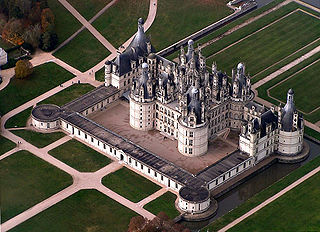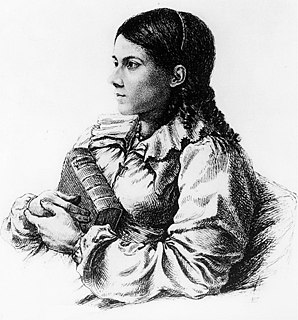
Bettina von Arnim, born Elisabeth Catharina Ludovica Magdalena Brentano, was a German writer and novelist.

Schloss Altenstein is a Schloss or palace upon a rocky hill on the south-western slope of the Thuringian Forest, not far from Eisenach, Thuringia, Germany. It was the summer residence of the Dukes of Saxe-Meiningen, and is surrounded by 160 hectares of English landscape garden, which contain, among other objects of interest, a cavern 300 metres long, through which flows a large and rapid stream.

Schönhausen Palace is a Baroque palace at Niederschönhausen, in the borough of Pankow, Berlin, Germany. It is surrounded by gardens through which the Panke river runs. The palace is maintained by the Prussian Palaces and Gardens Foundation Berlin-Brandenburg and reopened to the public in 2009 after extensive restoration.

Niederstotzingen is a small city in the district of Heidenheim in Baden-Württemberg in southern Germany. It is situated 17 km southeast of Heidenheim, and 24 km northeast of Ulm. The city consists of four sections or villages; Niederstotzingen, Oberstotzingen, Stetten ob Lontal and the combined section Lontal und Reuendorf. There are 4,850 inhabitants.
Schloss Johannisberg is a castle and winery in the village of Johannisberg to the west of Wiesbaden, Hesse, in the Rheingau wine-growing region of Germany. It has been making wine for over 900 years. The winery is most noted for its claim to have "discovered" late harvest wine. The castle is a venue of the Rheingau Musik Festival, made available by co-founder Tatiana von Metternich-Winneburg.

Dahlen Castle is a castle built between 1744 and 1751 in the small town of Dahlen, located in Saxony, Germany.

Schloss Hohenheim is a manor estate in Stuttgart, eponymous of the Hohenheim city district. The original castle was a fief of the County of Württemberg, recorded for the 12th century. The estate fell into the possession of Charles Eugene, Duke of Württemberg in 1768, who had it re-built as a Rococo style manor with extensive gardens and residential palace for his future wife, Franziska von Hohenheim. The estate was the main ducal residence during 1772–1797, when it fell to the city of Stuttgart. An Agricultural Educational Testing and Model Institution was housed here in 1818, and the estate remains in use by the Horticulture and Agriculture Departments of the University of Hohenheim.

Brenz an der Brenz is a borough of the village of Sontheim in the Heidenheim District of Baden-Württemberg in Germany. Brenz an der Brenz was an independent village until it merged with Sontheim. The borough has about 1100 inhabitants.

Brenz Castle is Renaissance castle located in the Brenz an der Brenz borough of Sontheim in Heidenheim district of Baden-Württemberg in Germany. The current castle was built in 1672 and rests on the remains of an earlier castle destroyed during the Thirty Years' War. Within the castle is a small Community Heritage Museum that is open on Sundays, Holidays or by appointment and hosts several concerts throughout the year.
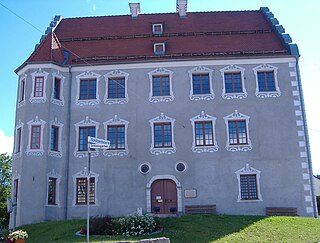
Ballmertshofen Castle is a 16th-century castle located in the Ballmertshofen section of Dischingen in the Heidenheim district of Baden-Württemberg in Germany. It is located in the south east corner of Ballmertshofen on the road to Giengen and Dattenhausen. The castle is owned by the community and includes a local art gallery.
Schloss Oberstotzingen is a castle located at the north end of Niederstotzingen in the district of Heidenheim, Baden-Württemberg, Germany. At present it is a hotel and restaurant, though both are currently closed.

Berg Castle is a manor house situated on the east shore of Lake Starnberg in the village of Berg in Upper Bavaria, Germany. It is famous as the site of King Ludwig II of Bavaria's death. Today, it remains home to the head of the house of Wittelsbach, currently Franz, Duke of Bavaria.
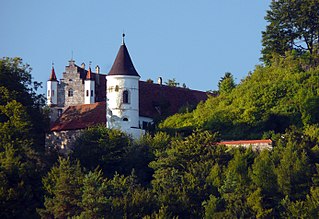
Schloss Neidstein is a castle located in the Upper Palatinate in Bavaria, Germany, in the municipality of Etzelwang.

Reichenbach castle is located in Zollikofen, about 5 kilometres north of Bern. The castle was founded as a medieval fort, probably built on the site of an earlier Roman fort, on the river Aar. The medieval castle was later rebuilt in the Baroque style. It is a Swiss heritage site of national significance.

Schloss Warthausen is a schloss near the town of Warthausen in Germany. It has been home to several famous historical personages, including authors Christoph Martin Wieland and Sophie von La Roche, and painter Johann Heinrich Tischbein. It was the traditional home of the Counts of Stadion-Warthausen. It is the subject of an article, The Gardens at Schloss Warthausen and Their Place in German Literature.

Schloss Bothmer is a Baroque palatial manor house ensemble in northern Germany. It was built for Count Hans Caspar von Bothmer to designs by architect Johann Friedrich Künnecke in 1726–32. It remained the property of the Bothmer family until 1945. It is today owned by the State of Mecklenburg-Vorpommern and, following a renovation in 2009–15, open to the public. It is the largest Baroque-era country house ensemble in Mecklenburg-Vorpommern.

Uster Castle is a hill castle which was built probably around 1200 AD by the House of Rapperswil in the Swiss municipality of Uster in the Canton of Zürich. Since 1995 it houses a boarding school.
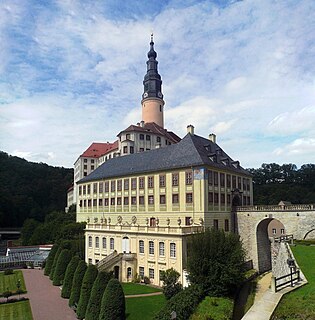
Schloss Weesenstein is a Schloss located in Weesenstein, a small village, part of Müglitztal in the Müglitz river valley, around 3 kilometres (1.9 mi) south of Dohna in Saxony, Germany.

Schloss Krobnitz is a Schloss in Reichenbach (Oberlausitz), Saxony (Germany). Dating from the 17th century, it was the residence of the Prussian Minister of War Albrecht von Roon during the 19th century.







